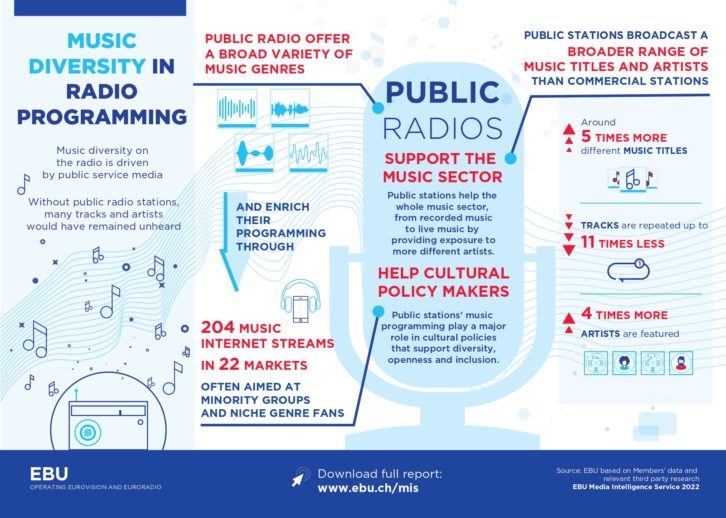Radio World’s “Guest Commentaries” section provides a platform for industry thought leaders and other readers to share their perspective on radio news, technological trends and more. If you’d like to contribute a commentary, or reply to an already published piece, send a submission to [email protected].
Matthieu Rawolle is a media analyst at European Broadcasting Union’s Media Intelligence Service (MIS). EBU commentaries appear regularly at radioworld.com. Here, Rawolle shares what EBU found when measuring music diversity at public radio stations across Europe, and what impact such music diversity/variety can have on the industry.
When comparing public service broadcasters’ music programming with commercial ones, listeners can use subjective arguments such as the quality of the music or if it suits their taste. However, neutral and quantitative indicators also exist.
At the EBU, we found that public stations broadcast around five times the number of unique music titles than commercial competitors.
This striking figure comes from our latest report about music diversity in radio programming. Based on EBU’s Members data and third parties recent* research, it focuses mainly on three key indicators: broadcast hours per music genre, unique music titles and different artists featured in the programming.
Across 15 EBU markets, in public service broadcasters’ programming, pop music was the single biggest genre, making up 46%. However, other genres were also significant contributors such as Classical (18%), Folk/Traditional (9%), Rock (6%) and Urban (4%).
At the station level, different programming strategies are carried out. One quarter of public stations boast highly eclectic music programming while two thirds are dedicating more than half of their programming to one genre. Organizations enrich their linear music programming offer with online streams, often aimed at minority groups and niche music enthusiasts. Across 22 markets, we found 204 of these online streams, including, for example, NPO’s FUNX “Arab,” France Musique’s “Baroque” or Classic 21 “Metal.”

Public service broadcasters play a greater variety of tracks than commercial stations.
In German-speaking Switzerland, public stations played on average 4.5 times more unique titles than commercial ones. In France, 3 of the 4 public stations covered by the study ranked in the top-5 radio stations which broadcast the highest number of unique music titles (among a total of 42 stations researched). In Belgium Flanders, 72% of all tracks played on the main national stations were only broadcast on VRT stations. In the United Kingdom, commercial radio stations repeated each track 11 times more than the BBC. Finally, among Hungary’s most popular stations, the ones broadcasting the highest number of unique titles were all public.
Public service broadcasters play music from a wider range of artists than commercial stations.
In Belgium Flanders, without VRT, 68% of all featured artists would have remained unheard on the main national stations. In France, public stations featured 6400 different artists and commercial stations only 1700.
Undoubtedly, public service broadcasters have a unique contribution to radio industry, crucial for music diversity.
By covering a broad range of music genres, having a richer music catalogue, and highlighting more artists than commercial stations, they have a decisive economic impact on the music sector. They give exposure to artists who will have a greater chance to increase their records sales and attract more audiences to live performances.
Moreover, they also help cultural policymakers who strive for less concentration and more diversity, open-mindedness, and inclusion.
* The analysis period is full-year 2020 for all results besides Switzerland (Full Year 2015) and Hungary (Full Year 2019).










